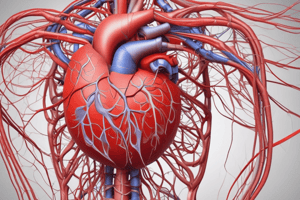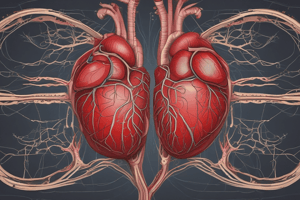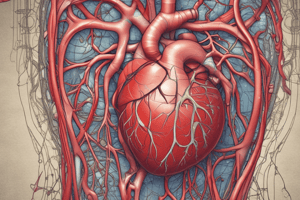Podcast
Questions and Answers
Match the following terms with their definitions:
Match the following terms with their definitions:
Stroke Volume = Volume of blood pumped by a ventricle in 1 min. Heart Rate = Volume of blood pumped per ventricle per contraction. Cardiac Output = Number of heart beats in 1 min. Preload = The degree ventricular walls are stretched at end of diastole.
Match the following formulas with their descriptions:
Match the following formulas with their descriptions:
CO = SV × HR = Formula to calculate cardiac output. SV = CO / HR = Formula to calculate stroke volume. HR = CO / SV = Formula to calculate heart rate. CO = HR / SV = Formula to calculate cardiac output per minute.
Match the following terms with their units:
Match the following terms with their units:
Stroke Volume = Liters/beat. Heart Rate = Beats/min. Cardiac Output = Milliliters/min. Preload = Milliliters
Match the following terms with their relationships:
Match the following terms with their relationships:
Match the following terms with their descriptions:
Match the following terms with their descriptions:
Match the following terms with their values:
Match the following terms with their values:
Match the following terms with their effects on cardiac output:
Match the following terms with their effects on cardiac output:
Match the following terms with their relationships:
Match the following terms with their relationships:
Match the following terms with their definitions:
Match the following terms with their definitions:
Match the following terms with their descriptions:
Match the following terms with their descriptions:
Study Notes
The Cardiovascular System
- The heart is a muscular organ essential for life, pumping blood throughout the body.
- The cardiovascular system consists of the heart, blood vessels, and blood.
- A healthy adult heart pumps approximately 5 liters of blood per minute.
Heart Structure and Function
- The heart is actually two pumps in one, with the right side pumping blood to the lungs and back to the left side of the heart.
- The left side pumps blood to all other body tissues and back to the right side of the heart.
- The heart generates blood pressure, routes blood, ensures one-way blood flow, and regulates blood supply.
Heart Characteristics
- Size: the size of a fist, weighing less than 1 lb.
- Location: between the lungs in the thoracic cavity.
- Orientation: apex (bottom) points towards the left side.
Pericardium
- A double-layered sac that anchors and protects the heart.
- Consists of parietal pericardium (outer membrane) and visceral pericardium (inner membrane).
- Pericardial cavity: space between the two layers.
Heart External Anatomy
- A coronary sulcus extends around the heart, separating the atria from the ventricles.
Control of Heart Valves
- Papillary muscles in the ventricles contract to prevent valves from opening into the atria.
- Chordae tendineae connect papillary muscles to valve cusps.
Semilunar Heart Valves
- Located between the ventricles and arteries.
- Pulmonary valve (between RV and pulmonary trunk) and aortic valve (between LV and aorta).
- Each valve has three half-moon shaped cusps.
Cardiac Cycle
- Atrial systole: contraction of atria.
- Ventricular systole: contraction of ventricles.
- Atrial diastole: relaxation of atria.
- Ventricular diastole: relaxation of ventricles.
Heart Sounds
- Heart sounds are produced due to the closure of heart valves.
- A stethoscope is used to hear heart sounds.
- The first heart sound makes a ‘lubb’ sound, while the second heart sound makes a ‘dupp’ sound.
- The first heart sound is from atrioventricular valve closure, while the second heart sound is from semilunar valve closure.
Heart Function Regulation
- Stroke Volume: volume of blood pumped per ventricle per contraction (around 70 milliliters/beat).
- Heart Rate: number of heart beats in 1 minute (around 72 beats/min).
- Cardiac Output: volume of blood pumped by a ventricle in 1 minute (CO = SV × HR).
- CO = 5 Liters/min in a healthy adult.
Intrinsic Regulation of the Heart
- Venous return: the amount of blood that returns to the heart.
- Preload: the degree ventricular walls are stretched at the end of diastole.
- Venous return, preload, and stroke volume are related to each other.
Studying That Suits You
Use AI to generate personalized quizzes and flashcards to suit your learning preferences.
Description
Test your knowledge on the heart and its functions as a part of the cardiovascular system. Learn about the muscular organ that pumps blood through the body. Based on Seeley's Essentials of Anatomy & Physiology, 11th Edition.





